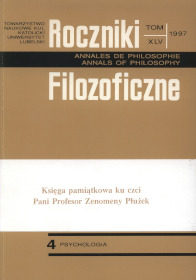Reakcje emocjonalne a aktywność katecholaminergiczna u dzieci w sytuacji przewlekłego stresu
Abstrakt
In 104 children with emotional disturbances at the age of puberty and in 30 healthy peers personality studies were carried out and 24-hour urinary excretion of catecholamines (adrenaline and noradrenaline) was determined.
Among these emotional symptoms the most frequent ones were such as hyperexcitability, anxiety, patho1ogical habits and sleep disturbances.
The indices of anxiety and introversion showed a high intensity of anxiety and features of introversion in children with these disturbances.
The catecholaminergic activity was studied in relation to the type of emotional disturbances, and increased adrenaline excretion was found in children with aggressive reactions, with hyperexcitability and sleep problems. Noradrenaline excretion was decreased in children with various emotional symptoms: hyperexcitability and anxiety reactions, inhibition and emotional depression.
Bibliografia
Al-Damluji S. (1993). Adrenergic control of the secretion of anterior pituitary hormones. Clinical Endocrinology and Metabolism, 7, 355-392.
Ax A. F. (1953). The physiological differentiation between fear and anger in humans. Psychosomatic Medicine, 15, 33-39.
Bergman L. R., Magnusson D. (1979). Overachievement and catecholamin excretion in an achievment demanding situation. Psychosomatic Medicine, 41, 181-187.
Buch1er H. U. (1978). Plasma adrenaline, noradrenaline and dopamine in man and different ani¬mal species. Journal of Physiology, 176, 311-319.
Burrows D. S., Norman R. (1996). Stress, neurotransmitters and depression. W: R. Mc Carty (red.), Stress. Amsterdam: Harwood Academic Publishers, s. 819-832.
Cattel R. B., Beloff H., Coan R. W. (1958). The High School Personality Questionaire. Champaign: IPAT.
Chomuło P. S., Chuchrina L. A. (1980). Dinamika izmienienija urownia kortykosterydow w krowi i tkanjach i katecholaminow w mocze krys w processie razwitja reakcji k emocjo¬nalnemu naprażeniju. Problemy Endokrinołogii, 26, 56-61 .
Conner R. L. (1972). Hormones, biogenic amines and aggression. W: S. Levine (red.), Hormones and Behavior. New York: Academical Press, s. 207-218.
Dantzer R., Mormede P. (1985). Stress in domestic animals: a psychoneuroendocrine aproach. W: G. P. Moberg (red.), Animal Stress. Bethesda: American Physiological Society, s. 81-95.
Erdman G., Lindern B. (1980). The effects of beta-adrenergic stimulation and beta-adrenergic blockade on emotional reactions. Psychophysiology, 17, 332-343.
Felten D. L., Felten S. Y., Bellinger D. L., Madden K. S. (1993). Fundamental aspects of neural-immune signaling. Psychotherapy and Psychosomatics, 60, 46-56.
Frankenhaeuser M. (1975). Experimental approaches to the study of catecholamines and emotion. W: L. Levi (red.), Emotions – their parameters and measurement. New York: Raven Press, s. 209-216.
Frankenhaeuser M. (1976). The role peripheral catecholamines in adaptation to understimu¬lation and overstimulation. W: G. Serban (red.), Psychopathology of Human Adaptation. New York: Plenum Publicion, s. 126-134.
Goldstein D. S. (1986). Stress, catecholamines and cardiovascular disease. W: R. Mc Carty (red.), Stress. Amsterdam: Harwood Academic Publishers, s. 833-862.
Górny D. (1964). Fluorymetryczna metoda ilościowego oznaczania, wolnej adrenaliny i norad¬renaliny w moczu. Polski Tygodnik Lekarski, 19, 632-637.
Hellhammer D. H., Wade S. (1993). Endocrine correlates of stress vulnerability. Psychotherapy and Psychosomatics, 60, 8-17.
Henry J. P. (1971). Effect of psychosocial stimulation on the enzymes involved in the biosynthesis and metabolism of noradrenaline and adrenaline. Psychosomatic Medicine, 33, 227-238.
Konarska M., Steward R. E., Mc Carty R. (1995). Responsiveness of sympathetic – adrenal medullary system in chronically stressed laboratory rats, three types of response. Journal of Physiology and Pharmacology, 46, 44, suppl. 1.
Kopin I. J. (1979). Biological assesment of peripheral adrenergic activity. W: D. M. Paton (red.), The release catecholamines from adrenergic neurones. Oxford: Pergamon Press, s. 355-362.
Kvetnansky R., Weise V., Kopin I. J. (1976). The origins of plasma epinephrine, norepinephrine and dopamine levels in stressed rats. W: E. Usdin (red.), Catecholamines and stress. Oxford: Pergamon Press, s. 684-686.
Kvetnansky R., Fukuara K., Pacek K., Cizza G., Goldstein D. S., Kopin I. J. (1993). Endogenous glucocorticoids restrain catecholamine synthesis and release at rest and during immobilizat on stress in rats. Endocrinology, 133, 1411-1419.
Le Blanc J. (1979). Plasma catecholamines and cardiovascular responses to cold and mental activity. Journal Applied Physiology, 47, 1207-1211.
Levi L. (1972). Stress and distress in response to psychosocial stimuli. Stockholm: Almquist, Wiksell Periodical Company.
Lindberg L. (1978). Urinary catecholamines, stress and psychopathy: a study of arrested man awaiting trial. Psychosomatic Medicine, 40, 116-121.
Mason S. T., Fibiger H. C. (1979). Noradrenaline and fear. W: E. Usdin (red.), Catecholamines. New York: Pergamon Press, s. 1931-1940.
Mefferd R. B. (1979). Autonomic balance as a function of level anxiety. Psychophysiology, 16, 171-192.
Płużek Z. (1994). Szesnastoczynnikowy kwestionariusz R. B. Cattella – opracowanie. Lublin: KUL.
Sapolsky R. M. (1996). Stress, glucocorticoids and damage to the nervous system. Stress, 1, 1-19.
Scheinin M. (1986). Role monoamine neurotransmitters in the reaction to stress. W: K. Achte, A. Pacaslahti (red.), Stress and Psychosomatics. Helsinki: Psychiatria Fennica, s. 25-36.
Szewczyk L., Zajączkowska M. (1973). Aktywność układu adrenergicznego w stanach nerwicowych i depresyjnych. Pediatria Polska, 47, 1485–1499.
Szewczyk L. (1985a). Zaburzenia psychonerwicowe w okresie dojrzewania a aktywność układu adrenergicznego. Pediatria Polska, 60, 30:5-311.
Szewczyk L. (1985b). Rola układu adrenergicznego w warunkach fizjologicznych i stresie. Pediatria Polska, 60, 34:3-349.
Szewczyk L., Szewczyk A., Witkowski D. (1997). Catecholaminergic activity and or¬gan-specificity of emotional stress disturbances in adolescents. W: Stress of Life (s. 195). Budapest: International Congress of Stress.
Uhde T. W., Boulenger J. P., Post R. M. i in. (1984). Fear and anxiety: relationship to noradrenergic function. Psychopathology, 17, 8-23.
Woodman D. D. (1978). Urinary catecholamines and test habituation in maximal security hospital patients. Journal of Psychosomatic Research, 23, 263-270.
Copyright (c) 1997 Roczniki Filozoficzne

Utwór dostępny jest na licencji Creative Commons Uznanie autorstwa – Użycie niekomercyjne – Bez utworów zależnych 4.0 Międzynarodowe.





